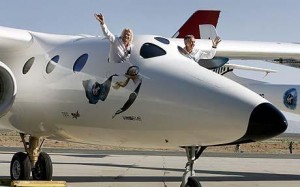
Sub-orbital space travel could bring increased demand for Spanish property
When we try to paint the future, do we create a picture that is wildly far-fetched or simply misjudged? Many creative dreamers of the ’50s and ‘60s imagined we’d all be piloting flying cars by now, but could they have ever envisioned that nearly every adult in the western world would carry in their pocket a phone ten times more powerful than the computers that put Neil Armstrong and Buzz Aldrin on the moon?
Probably not…
So we shouldn’t be afraid to dream of what tomorrow might bring, because most of us will likely be way off. But respected Sunday Times columnist and self-styled Spanish Property Doctor Mark Stucklin has hit upon a rather unique future fancy that he believes could have positive repercussions for Spain’s property market.
Estate agents Knight Frank last week published their 2014 Wealth Report in which the prospect of the impact sub-orbital flights could have on global property markets was addressed. Sub-orbital flights are essentially edge-of-space travel – a method of transport that dramatically reduces flight times, shrinking the earth to an easily navigable neighbourhood.
For Stucklin, such an aviation evolution would bring added interest to the property markets of the world’s most desirable areas, such as Spain.
“Increased access to beautiful places like Spain nearly always drives up demand for real estate,” he said. “Changing technology like fast trains, or new business models like low-cost air travel, have helped lift the demand curve. If sub-orbital space travel becomes a reality, and not just limited to billionaires, then I imagine it would increase demand for high-end property in Spain.”
Stucklin did add that he does not foresee a seismic shift happening soon, but his assertions are backed up by Knight Frank, who predict that interest in far-flung real estate markets the world over could increase drastically if sub-orbital flight takes off.
The technology to launch this type of transport – where planes reach supersonic speeds during a brief launch into space – is already here. All that’s missing is a dedicated marketplace, although Virgin’s Richard Branson, predictably, is already working on that.
A sub-orbital flight cuts the flight time from London to Sydney from 21 hours to 2.2 hours, while New York to Moscow would become a 1.2-hour flight rather than the current 9.2 hours (although given the current political tensions between the two nations that might not be such a good thing).
“By travelling outside the earth’s atmosphere, gravitational forces will allow spacecraft to travel at over 4,000 miles per hour, so breakfast in Mayfair could easily be followed by lunch overlooking Sydney Opera House,” said Knight Frank’s Global Head of Residential Research, Liam Bailey (not quite taking into account time differences, but you see his point). “It doesn’t take much imagination to see the dramatic impact this innovation could have on global luxury property markets.”
The estate agent believes that wealthy American, Russian and Chinese investors will be more tempted to invest their capital in somewhere other than London – currently the leading overseas property destination thanks to its convenient location – which could have a dramatic impact on property prices in places like Spain and Italy.
“Take second homes in Europe right now,” added Bailey. “Demand is mainly restricted to European investors, who try to limit their travel to less than two hours.
“In future, that same time-limit could allow Chinese or Indian investors to pop over for the weekend to visit their Tuscan farmhouse.”
 en
en



 Vlaams-Nederlands
Vlaams-Nederlands
0 Comments
Leave a Comment
DISCLAIMER
The opinions and comments expressed by contributors to this Blog are theirs alone and do not necessarily reflect the views of VIVA Homes Under the Sun Ltd, any of its associated companies, or employees; nor is VIVA to be held responsible or accountable for the accuracy of any of the information supplied.
Have you got something to say?